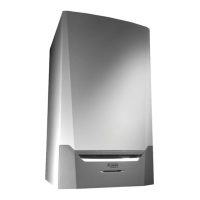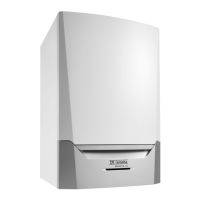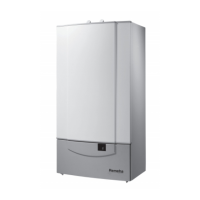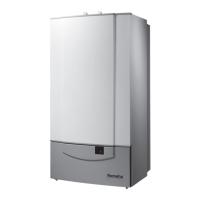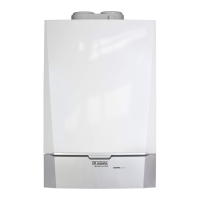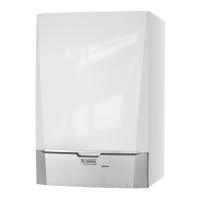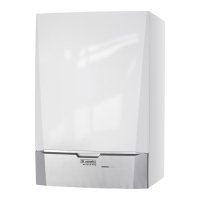What to do if my REMEHA Quinta Ace 135 Boiler shows a Water Press Warning?
- EevanssusanAug 31, 2025
If your REMEHA Boiler displays a Water Press Warning, it indicates that the water pressure is too low. Check the water pressure.
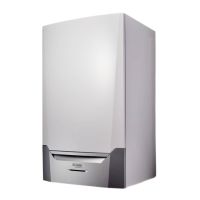
What to do if my REMEHA Quinta Ace 135 Boiler shows a Water Press Warning?
If your REMEHA Boiler displays a Water Press Warning, it indicates that the water pressure is too low. Check the water pressure.
What causes the WaterPressureOpen error on my REMEHA Quinta Ace 135 Boiler?
The 'WaterPressureOpen' error on your REMEHA Boiler means the hydraulic pressure sensor is open. To address this: * Check the wiring and connectors for bad connections. * Ensure the sensor is correctly fitted. * If the sensor is faulty, replace it.
Why does my REMEHA Quinta Ace 135 display Max Delta TH-TR error?
The Max Delta TH-TR error on your REMEHA Boiler indicates that the maximum difference between the heat exchanger and return temperature has been exceeded. This is often due to: * Insufficient or no flow: Check the circulation (direction, pump, valves). * Low water pressure: Check the water pressure. * A dirty heat exchanger: Check the cleanliness of the heat exchanger. * Air in the system: Check that the installation has been correctly vented to remove air. * Sensor error: Check that the sensors are operating correctly and that the sensor has been fitted properly.
What to do if REMEHA Boiler shows TFlow Open error?
If your REMEHA Boiler displays a 'TFlow Open' error, it means the flow temperature sensor is either removed. To fix this: * Check the wiring and connectors for bad connections. * If the sensor is faulty, replace the sensor.
Why is my REMEHA Quinta Ace 135 Boiler showing TFlow Closed error?
The TFlow Closed error on your REMEHA boiler means the flow temperature sensor is shorted. To resolve this: * Check the wiring and connectors for bad connections. * Ensure the sensor is correctly fitted. * If the sensor is faulty, replace the sensor.
What does Waiting For Configuration Number mean on my REMEHA Quinta Ace 135?
The 'Waiting For Configuration Number' error on your REMEHA Boiler indicates a configuration error or unknown configuration number. Reset CN1 and CN2 to resolve this.
What to do if my REMEHA Quinta Ace 135 has 5x Flame Loss Error?
If your REMEHA Boiler displays a 5x Flame Loss Error, it means flame loss has occurred 5 times. Here's what you should do: * Vent the gas supply to remove air. * Ensure the gas valve is fully opened. * Check the gas supply pressure. * Verify the operation and setting of the gas valve unit. * Confirm that the air supply inlet and flue gas outlet are not blocked. * Ensure there is no recirculation of flue gases.
What to do if my REMEHA Quinta Ace 135 Boiler displays warning A .00.00?
If your REMEHA Boiler displays warning A .00.00, the controls will continue to operate, but the cause of the warning must be investigated. Keep in mind that a warning can change into a blocking or lock-out.
What to do if my REMEHA Boiler displays error H .00.00?
If your REMEHA Boiler displays error code H .00.00, the controls will stop normal operation and will check with set intervals if the cause of the blocking still exists. Normal operation will resume when the cause of the blocking has been rectified. Note that a blocking can become a lock-out.
What to do if my REMEHA Quinta Ace 135 Boiler displays error E .00.00?
If your REMEHA Boiler displays error code E .00.00, the controls will stop normal operation. The cause of the lock-out must be rectified, and the controls must be reset manually.
Instructions on safety for installers and end users regarding gas and flue gases.
Advice on appliance usage, installation, and maintenance by qualified personnel.
Details manufacturer, installer, and user responsibilities.
Overview of the manual's scope and content.
Explains symbols like Danger, Warning, Caution, and Important.
Provides detailed specifications like output, input, and gas/flue gas data.
Shows physical dimensions and connection points for pipes and gas.
Illustrates the electrical connections and components of the boiler.
Highlights key features like high-efficiency and low emissions.
Explains how the boiler functions, including gas/air regulation and combustion.
Lists and illustrates the main internal parts of the boiler.
Describes the control panel layout and its components.
Specifies installer qualifications and general regulations.
Discusses factors for selecting the installation site.
Instructions for transporting the boiler package.
Step-by-step guide for unpacking the boiler.
General statement about installation by a qualified installer.
Guidance on mounting the boiler bracket and the boiler itself.
Details on connecting the central heating flow and return pipes.
Steps for connecting the gas supply pipe.
Overview of flue gas connection types and material selection.
General recommendations for electrical connections.
How to mount the control panel and connect it to the PCB.
Step-by-step guide for connecting the connection box.
How to connect a system pump to the boiler.
Connecting OpenTherm thermostats and other regulators.
How to connect and configure the release input for boiler control.
Overview of the commissioning steps.
Step-by-step guide for initial boiler commissioning.
Adjusting gas type and checking gas/air ratio.
Measuring O2/CO2 at full and part load.
Final checks, sticker completion, and user instruction.
How to navigate and use the control panel.
Procedure for safely shutting down the boiler.
How the frost protection system works and its limitations.
Overview of parameter adjustment and optimization.
Steps to access the installer level with an access code.
Detailed tables of factory settings for various parameters.
How to view current operational values from sensors.
Explains system status and sub-status codes.
General notes on boiler maintenance and service.
Procedure for resetting service messages after maintenance.
General inspection and maintenance tasks.
Steps to check and maintain correct water pressure.
How to check the ionisation current.
Detailed procedure for checking the APS.
Instructions for checking the burner and cleaning the heat exchanger.
Procedure for replacing the ionisation/ignition electrode.
How to check and replace the non-return valve.
Instructions for safe removal and disposal of the boiler.
Explains error codes and their meaning.
How error codes are displayed and what they mean.
Lists warning codes and their solutions.
Lists blocking codes and their solutions.
Lists locking codes and their solutions.
How to read and clear the error memory.
Product fiche with energy efficiency and output data.
A checklist of tasks for commissioning the boiler.
A checklist for performing annual maintenance.

